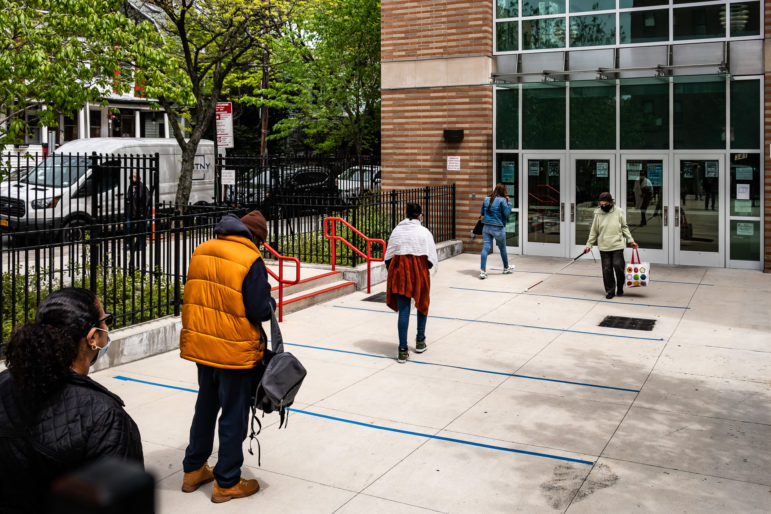‘Crossing this milestone is bittersweet – a mark of what the government and civic sector can accomplish…but also a sad reminder that too many people were hungry before this crisis exacerbated the situation, and too many are still hungry today.’

Adi Talwar
Residents lined up at one of the city’s free meal hubs in May.It is an almost unfathomable amount of food – 200 million meals, enough for one person to eat three meals per day for 180,000 years, or for every single New Yorker to eat for more than a week. That’s the amount the City of New York has distributed to people in need during the 10 months from the start of the COVID-19 pandemic in March of last year through the end of January 2021.
Crossing this milestone is bittersweet – a mark of what the government and civic sector can accomplish when we work together, but also a sad reminder that too many people were hungry before this crisis exacerbated the situation, and too many are still hungry today.
 CityViews are readers’ opinions, not those of City Limits. Add your voice today!
CityViews are readers’ opinions, not those of City Limits. Add your voice today!
When Mayor Bill de Blasio first launched the GetFoodNYC emergency relief programs, we were looking to provide food to three groups: people already experiencing food insecurity whose normal access points like pantries, soup kitchens, and senior centers might be interrupted by the pandemic; people at especially high-risk of contracting COVID-19 who were being told to stay inside at all costs, like seniors and those with comorbidities; and people experiencing food insecurity for the first time because of the economic crash. These groups had different needs, be they home-bound, income-restricted, or both. We had to do whatever we could.
We set up multiple programs, including Grab & Go operations at hundreds of Department of Education school sites, and emergency home food delivery for people who could not go out, had no one to go out for them, and could not afford private options. The city and City Council worked together to provide tens of millions of dollars in emergency funding for food pantries, on top of the tens of millions they had received from the city before the pandemic. And when the federal government created a special grocery benefit for parents of school children, we worked together to get the word out to people in need.
As we have analyzed the data on these 200 million meals, a few things have stood out. When we began, we expected usage to track closely to the spread of the virus – the more hard-hit an area by COVID-19, the more need there would be for emergency food as people stayed home. While this was largely true in the spring and early summer last year, since then, usage has tracked more closely to income, poverty, and pre-existing food insecurity. The Bronx has been the borough with the greatest demand for home delivery, for example, even as COVID-19 cases have spiked in red zones in Brooklyn and Queens.
In September, New York City commissioned a survey which found that for slightly more than half of recipients of GetFoodNYC programs, this is their only source of food. Of the people we serve, 79 percent are below the federal poverty line, while 68 percent are at elevated risk of COVID-19, and 75 percent said their ability to afford food has significantly decreased due to the pandemic. Clearly, there is extreme need, as there was before the pandemic, and as there will be after it is gone.
There are some optimistic signs on the horizon. A new Executive Order signed by President Biden allows states to increase SNAP benefits by 15 percent, putting more money into the hands of people who need food, and providing much needed revenue to our local food businesses. The city’s Pandemic Food Reserve Emergency Distribution program, established by Mayor de Blasio as part of the FeedingNYC plan, has gotten nearly 6 million pounds of fresh produce to pantries and community-based organizations and will distribute at least another 12 million pounds of food before July. And demand for emergency home food deliveries continues to decline. At the height of the shutdowns in New York City last May, the city was distributing over 10 million free meals each week. Now, it is closer to one to two million, as much of the city has partially reopened. For people receiving that food, though, it is still a critical lifeline.
Before COVID-19, around 1.2 million New Yorkers experienced food insecurity – a shocking and unacceptable number, and pantries and government already worked hard to serve them. In June 2020, based on SNAP applications and unemployment claims, we estimated that number had nearly doubled, to 2.2 million. Today, we believe it has settled somewhere in between, at around 1.6 million. The pandemic did not cause food insecurity, but it exposed it in so many parts of the city. As we distribute our 200 millionth meal, we celebrate the work we have done to help people in need and recommit ourselves to eradicating the scourge of hunger once and for all.
Kate MacKenzie is the director of the New York City Mayor’s Office of Food Policy. Dr. Melony Samuels is the CEO of The Campaign Against Hunger.









One thought on “Opinion: NYC Has Distributed 200 Million Pandemic Meals–But There’s More to do to Fight Hunger”
helping food is not only the task of the government, but people have more economies should also help overcome this